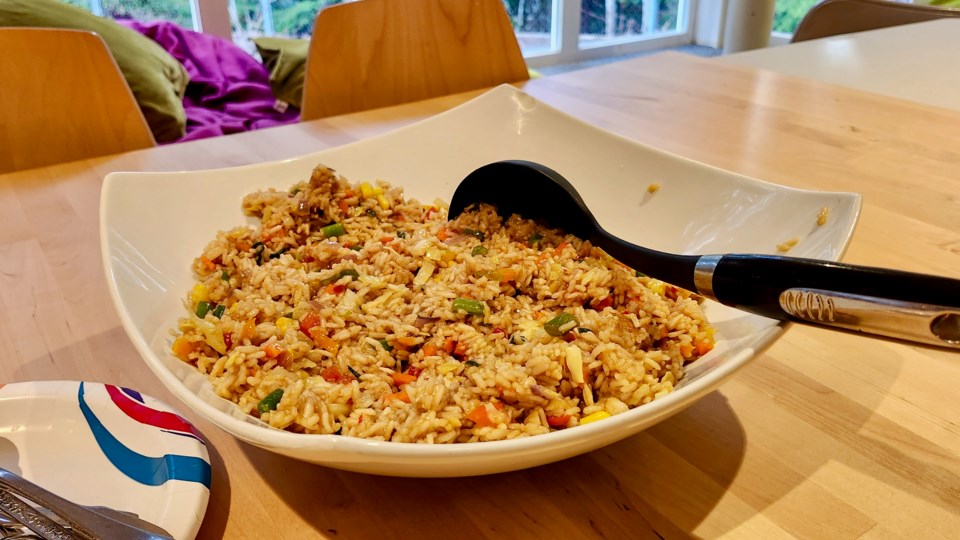On a recent overcast Thursday evening, Whistler's Multicultural Community Kitchen (MCK) met to catch up over a home cooked meal. I was the first guest to arrive, meeting organizers from the Whistler Multicultural Society, a volunteer, and the couple sharing a meal with attendees that evening.
The meal at hand was vagharelo bhaat, or Indian-style fried rice.
It’s a quick meal—combining rice, a base spice or sauce, and fast-cooking veggies.
I started cutting some green beans. Volunteers filed in, and set about slicing onions, cutting up peppers, and dicing carrots (a task my uncoordinated paws were uniquely ill-suited to). Guests from all over—Australia, France, Italy—mingled and chatted. Some were old friends. Others, like me, were brand new to the kitchen, but were welcomed nonetheless.
Nisha Kalsi, one of the two cooks leading the evening, noted aged basmati rice is best to use; it’s a white, long-grained rice that grows in the foothills of the Himalayas in India and Pakistan.
The rice was cooked in salted water and then drained, reducing starch and giving it a fluffy appearance. Kalsi gave a breakdown of the significance of the dish as she and her husband, Happy, served it to the assemblage.
“It reminds us of home, like we have those family kitchens, so many people coming in," she said. "That's like the same feeling to us. So very happy to be here with all of you today.”
MCK dinners are part tutorial, part social event. Volunteer immigrant cooks prepare and share stories over meals to bring cultures together.
The vegetarian nature of the dish is a further reminder of home; Roughly 38 per cent of India identifies as vegetarian, making it the country with the highest percentage of vegetarians in the world.
“The region [this dish] comes from… It's not close to the sea or anywhere like where you need to hunt, or you will find fish, but we had so many ancient rivers [that] the land is so fertile and it gives you the opportunity to grow every single item which is present here," Kalsi said.
She also emphasized the importance of spice in Indian cuisine; not just for the taste, but for the ancillary benefits, too. The day’s meal uses soy sauce as a base, because the salt acts as a natural preservative. Meanwhile, cumin and coriander—"best friends of the liver,” said Kalsi—help make digestion easier, slowing down the process and allowing you to fully digest your meal.
The significance of the meal mirrors the WMK’s wider mission.
“It represents how we can integrate the food with the culture, such a combination of Indian and Chinese culture,” Kalsi told the assembled diners.
It’s a deeply personal task for Kalsi. She pointed to her own marriage as example of reaching across cultures; she’s Hindu, Happy’s Sikh.
“His religion and my religion, we offer food to our company, irrespective of their past, ethnicity, financial background... nothing else matters,” she said.
“Food helps us to connect with each other like family and friends. That's what we do. Like, even If you come to my house at like, say, 7 p.m. you're not going without food.”
An attendee quickly, only half-jokingly, asked for the address.
With plenty of basmati rice on the boil and more than 10 mouths to feed, three different types of the fried rice were made: the pure vagharelo bhaat pictured above, one infused with coriander and one with two different types of chili.
The coriander version is my standout favourite. The herb introduces a sweet, citrus-y flavour to the meal that complements the soy sauce base used for the rice.
The spicier version of the fried rice is a close second; pepper, paired with two types of chili, gives the vagharelo bhaat some zip, but not enough to overpower it or render it not do-able for a spice-averse diner like yours truly.
Towards the end of the evening, Kalsi notes it’s best to eat the vagharelo bhaat fresh, instead of letting it sit in the fridge for a while, to avoid upsetting your stomach. It’s a good excuse to dig in and eat ‘til we’re stuffed.
Looking to share a traditional meal? Get in touch with the MCK at [email protected]. A list of past recipes tackled by the kitchen can be found on their website.




